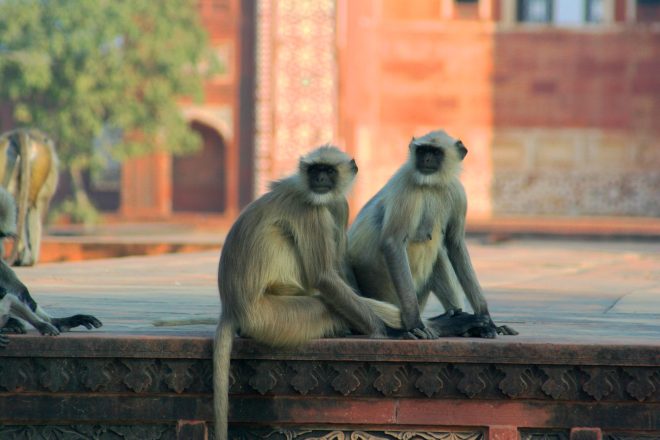Submissive Behavior
Biology 342 Fall 07
Clare Parker and Natalie Morgenstern
Adaptive Value
It is necessary to take a step back from how submissive behavior works and ask the question, “why does submissive behavior even exist in primates? What is the adaptive value of this behavior?” To answer these questions, it is a good idea to figure what would happen in conflicts between primates if they lacked the ability to show submission and defeat.
Why does submissive behavior exist in primates?
Social interactions happen very frequently in social primates. Aggressive and submissive interactions range from one monkey avoiding another to biting, hitting, kicking and chasing one another. Friendly post conflict acts can range from mild vocalizations with bared teeth display to mutual grooming. These post conflict acts occur more frequently in female-female interactions; only two adult males occasionally show this behavior.What is the adaptive value of this behavior?
While Indian langur monkeys do not display post conflict acts as often as expected (10), the existence of the behavior at all implies some sort of adaptive value, as it still exists and is not being selected against.
Given that conflict is inevitable, the best an organism can do is minimize the costs of the encounter. While aggressive interactions did include biting, kicking, hitting and chasing, incurring great overall harm was usually unlikely. Bite wounds require energy to heal, but serious wounds and broken bones are only rarely the result of these interactions. However, given dominance structures in social primates, a subordinate monkey who displays subordinance does not engage in conflict frequently. The adaptive value of this behavior is resource conservation. In a social setting, the health of members affects the entire group health. By avoiding a fight, monkeys stay healthy and conserve their resources which means that more resources are available for the rest of the group.
interactions did include biting, kicking, hitting and chasing, incurring great overall harm was usually unlikely. Bite wounds require energy to heal, but serious wounds and broken bones are only rarely the result of these interactions. However, given dominance structures in social primates, a subordinate monkey who displays subordinance does not engage in conflict frequently. The adaptive value of this behavior is resource conservation. In a social setting, the health of members affects the entire group health. By avoiding a fight, monkeys stay healthy and conserve their resources which means that more resources are available for the rest of the group.
Langur Monkeys; image from the University of Cambridge